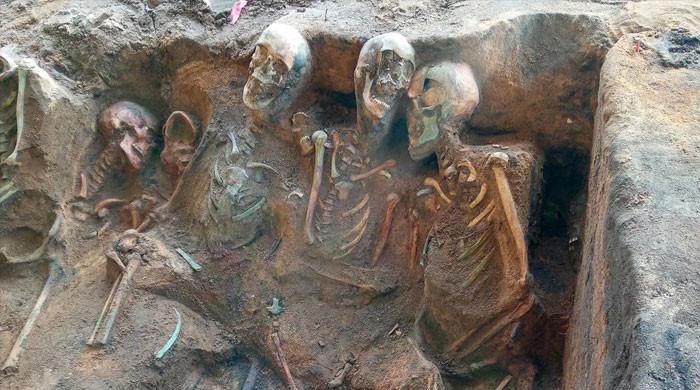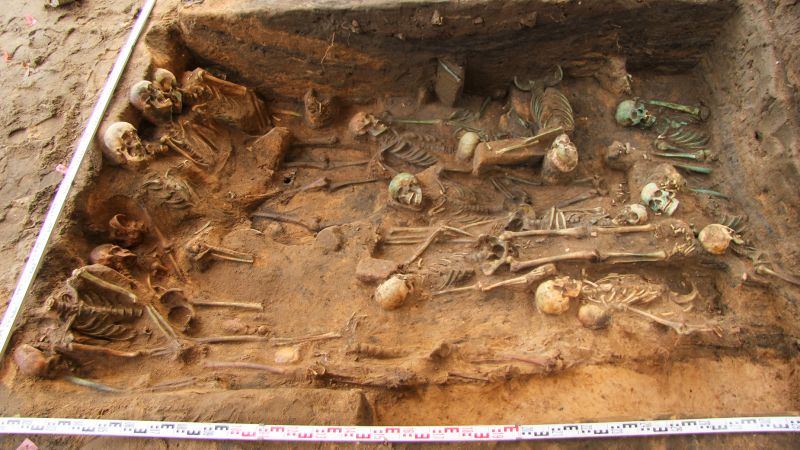Archaeologists have made a discovery in southern Germany, unearthing what could be Europe’s largest mass grave. With the uncovering of over 1,000 human skeletons in the city of Nuremberg.

Also Read: Dinocephalosaurus Orientalis: Palaeontologists Unveil 240 Million Year Old Dragon
The mass grave is believed to contain the remains of victims of the plague, an epidemic that ravaged Europe for centuries.
The skeletons, packed in burial pits, show a picture of the toll exacted by the deadly disease on the populace. The discovery shows realities faced by the people of Nuremberg during the 17th century.
Plague outbreaks were frequent, occurring approximately every decade from the 14th century onward. The city’s inhabitants lived in constant fear of the next deadly wave of disease.
The mass grave, found during routine archaeological screenings for a construction project, contains at least 1,000 sets of remains, with the potential for up to 1,500 bodies.
The victims are believed to have succumbed to the Black Death, with evidence pointing to the outbreak of the plague in the early 17th century.
Plague outbreaks were recurrent in Nuremberg, occurring approximately every decade since the 14th century. Determining the precise timeline of the remains has challenge for researchers.
Radiocarbon dating and historical documents have provided crucial clues, linking the mass grave to the epidemic of 1632-1633. This period was marked by death and suffering, by the concurrent Thirty Years’ War.
The scale of the mass grave is staggering, with estimates suggesting that it may contain upwards of 1,500 bodies. Julian Decker, overseeing the excavation, believes that the final count could surpass 2,000.
Also Read: British Museum Facing Social Media Campaign to Return Rapa Nui Statues
The composition of the buried individuals offers valuable insights into the demographics and health indicators of the city’s population during the 17th century. From children to the elderly, men and women of varying social statuses.
The excavation presents an opportunity for scientific analysis, with experts go to delve into various aspects of the remains.
From genetic mutations to dental health, the bones hold a wealth of information that could provide invaluable insights into life during this period.
This discovery confines of Nuremberg, resonating throughout Europe and beyond. Lord Mayor Marcus König aptly describes it as a moment of history, offering an empirically reliable glimpse into a pivotal period in the city’s history.
Victims were not interred in traditional cemeteries but in hastily dug pits, reflecting the overwhelming need to dispose of the deceased quickly.
This disregard for conventional burial practices speaks to the severity of the epidemic and the challenges faced by the local population.
Also Read: Blinkerwall: 10000 Year Old Stone Age Wall Found at Bottom of Baltic Sea
Radiocarbon dating and historical documentation, including a note from 1634 detailing the plague outbreak, provided crucial insights into the timeline and context of the mass grave.
These scientific methods allowed researchers to piece together the puzzle of the past and understand the circumstances surrounding the burial site.
The discovery show the intersecting forces of disease and conflict during this period in European history. The Thirty Years War by the effects of the plague, contributing to dire living conditions and mortality in Nuremberg and beyond.
The diverse composition of the victims, including men, women, children, and the elderly, offers a snapshot of society at the time.
By analyzing the skeletal remains, researchers can glean valuable information about population demographics, health indicators, and living conditions during the plague outbreak.
The bones unearthed in the mass grave serve as a treasure trove of information for scientists and anthropologists.
Through detailed examination, experts can study prevalence of diseases, genetic mutations, age distribution, and other factors that provide insights into the health and lifestyle of individuals during this historical period.
Also Read: Evidence of Homo Sapiens in Northern Europe 45000 Years Ago Discovered
























